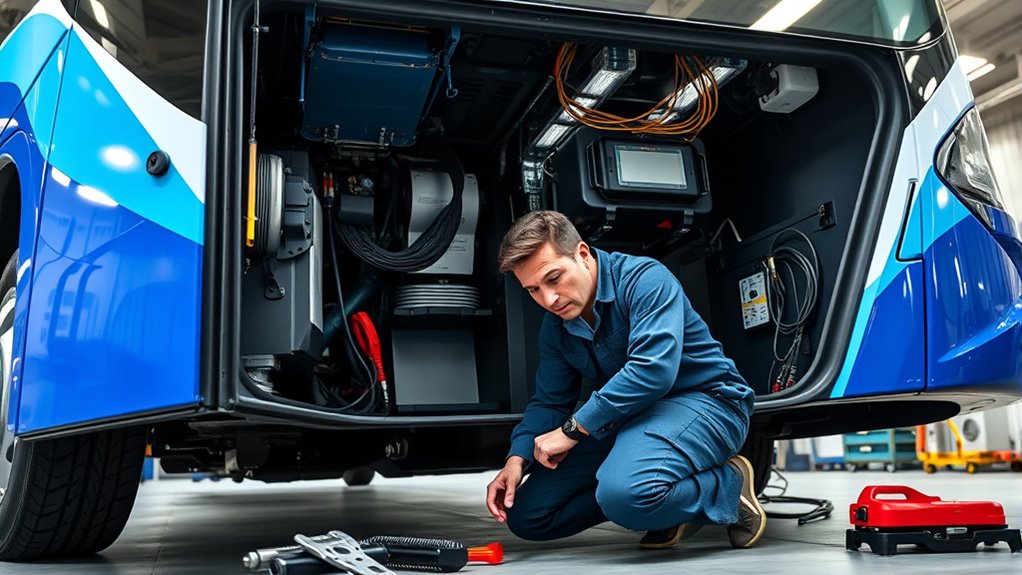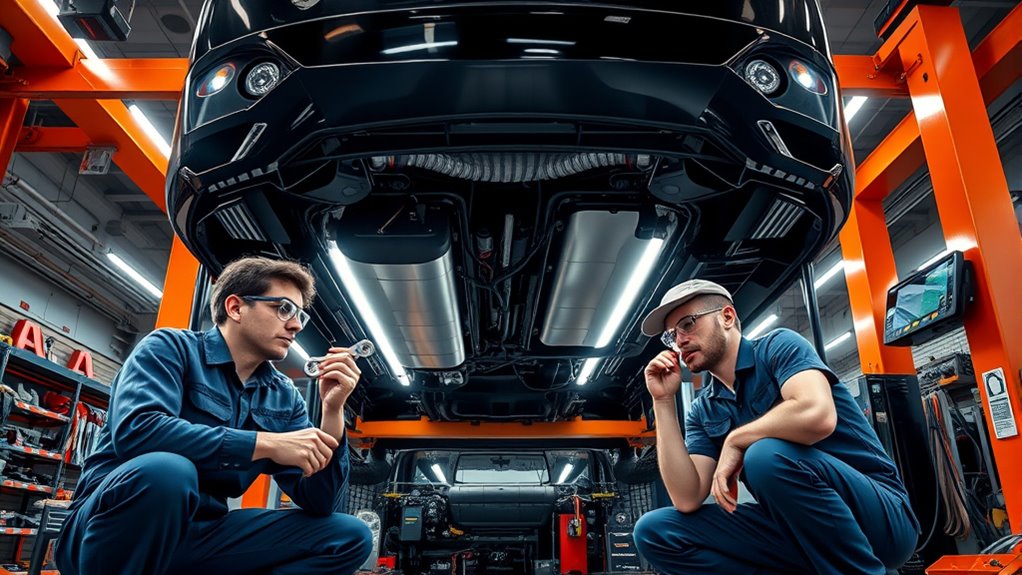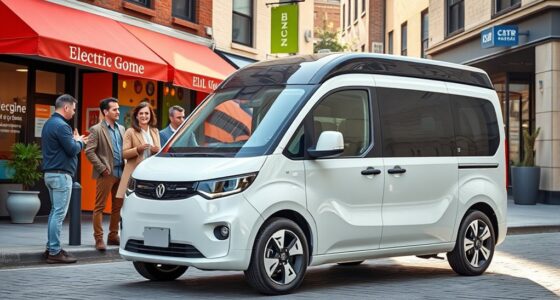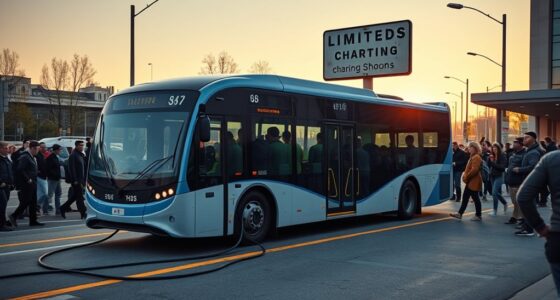As a mechanic working on electric buses, you need a new set of skills focused on high-voltage systems, advanced diagnostics, and safety protocols. You’ll work with specialized tools, interpret real-time data, and handle batteries safely with PPE and lockout procedures. Maintenance involves less traditional mechanical work and more electrical troubleshooting. The industry values EV experience and ongoing learning, meaning your skills must constantly evolve. Keep exploring to discover how today’s tech transforms your role.
Key Takeaways
- Mechanics must acquire specialized EV training, focusing on high-voltage systems and battery management for effective maintenance.
- Working on electric buses involves safety protocols like lockout/tagout and insulated tools due to high-voltage components.
- Diagnostic procedures rely on proprietary software and advanced tools such as thermal imaging, emphasizing IT troubleshooting skills.
- Reduced mechanical repairs shift technician focus toward electrical, electronic, and software diagnostics, impacting daily workflows.
- Ongoing education and staying current with evolving EV technology are essential for career growth and maintenance efficiency.

As electric buses become more prevalent, mechanics are experiencing a considerable shift in their roles and skill requirements. You now need specialized EV training to keep up with the technology, focusing heavily on high-voltage systems and battery management. This training isn’t just theoretical — you get hands-on experience working with actual electric buses, which helps you understand the unique components and safety protocols involved.
Hiring mechanics with prior EV experience is becoming standard, and ongoing education about software updates and diagnostics is essential to stay current in this rapidly evolving field.
Employers now prioritize EV experience and continuous learning to keep pace with advancing electric bus technology.
The complexity of the components in an electric bus differs sharply from traditional models. Electric motors, for example, contain roughly 20 moving parts compared to over 2,000 in combustion engines. This means you spend less time on engine oil changes or exhaust system repairs, but you need to be familiar with advanced power electronics and thermal management systems for batteries.
Regenerative braking considerably reduces brake wear—by about 80%—so inspections are needed less frequently, though brake systems still require routine checks. Tire and suspension maintenance remain similar to diesel buses, but you shift away from mechanical diagnostics to software-based troubleshooting. Battery monitoring systems enable predictive maintenance, helping you identify issues before they become serious problems.
Safety protocols have become more critical and complex. Lockout/tagout procedures for high-voltage circuits are mandatory, and you must use insulated tools when working on batteries. Fire suppression training specific to lithium-ion batteries is now part of your routine, along with strategies to mitigate arc flash hazards.
Personal protective equipment (PPE) has been upgraded to meet these new safety standards, ensuring you’re protected during high-voltage work. These protocols require a disciplined approach and constant awareness, but they’re essential for your safety and that of others.
Diagnostic tools have evolved from traditional OBD-II readers to proprietary EV software, thermal imaging devices, and cloud-based battery health monitoring systems. You learn to interpret real-time energy consumption data and automate fault code analysis, making troubleshooting more efficient. Additionally, staying current with diagnostic technology is essential for effective maintenance and repair.
As the industry continues to innovate rapidly, ongoing training in emerging EV safety protocols is crucial to adapt to new risks and standards. These tools demand a different skill set, blending mechanical expertise with IT troubleshooting, and you must stay proficient with the latest diagnostic technology to keep buses running smoothly.
Your job has shifted in many ways. Fewer technicians are needed per fleet because of reduced mechanical repairs, and your focus moves toward IT troubleshooting and software diagnostics.
Physical strain diminishes because fluid changes are eliminated, but your compensation tends to rise if you’re EV-certified. The job market now favors those with hybrid mechanical and IT skills.
Additionally, you must understand infrastructure maintenance, including charging stations, energy storage systems, and grid load management, to keep everything running efficiently. Keeping up with technological advances in high-voltage systems and diagnostic tools is essential for maintaining efficiency and safety.
Frequently Asked Questions
How Do Mechanics Handle High-Voltage Electrical Systems Safely?
To handle high-voltage electrical systems safely, you start by receiving specialized training and always wearing the proper PPE.
You verify systems are de-energized using lock-out, tag-out procedures before starting work.
You check that safety interlocks and proximity sensors are functioning, use insulated tools, and follow all safety standards and warning labels.
If an emergency arises, you know the proper response, ensuring your safety and that of others.
What Training Is Required for Mechanics Working on Electric Buses?
Did you know that specialized training can reduce electrical accidents by over 50%?
For working on electric buses, you need high voltage safety awareness, OEM-specific training, and ASE certification.
You must learn about electrical systems, battery management, lockout/tagout procedures, and PPE use.
Hands-on experience and in-depth courses guarantee you’re prepared.
Staying current with safety protocols and collaborating with OEMs helps you maintain safe, effective maintenance practices.
How Often Do Electric Bus Batteries Typically Need Replacement?
You probably wonder how often electric bus batteries need replacing. Typically, batteries should be replaced when they drop below about 70% capacity, which usually happens after several years of use, depending on driving conditions and maintenance.
Most manufacturers recommend replacement once the battery’s state of health falls below this threshold. Regular inspections and proper management can help extend battery life, delaying the need for replacement and maintaining ideal bus performance.
What Are Common Electrical Issues Encountered in Electric Buses?
You’ll often see electrical issues like loose power cables causing sudden propulsion loss, and body joint defects that create structural vulnerabilities.
Frequent breakdowns happen due to pothole damage or component failures, and recalls are common for manufacturer-specific problems.
You might also encounter charging challenges such as compatibility issues, limited infrastructure, and long recharge times, which all impact the bus’s reliability and operational efficiency.
Staying vigilant helps you address these electrical problems quickly.
How Do Mechanics Troubleshoot Regenerative Braking System Problems?
Imagine the bus slowing smoothly, then suddenly jerking or losing power—that’s a sign of regenerative braking issues. You check fault codes, monitor live data like battery SOC and motor torque, and test individual components.
Using specialized tools, you calibrate the system and update software. Regular inspections and proactive replacements help prevent these problems, so you keep the bus running safely and efficiently, restoring confidence in its braking performance.
Conclusion
You see, working on electric buses is changing how mechanics approach maintenance. With over 80% of issues now related to software or batteries, you realize the importance of continuous learning. This shift means you’ll need new skills but also enjoy fewer engine repairs and cleaner work environments. As you adapt, you’ll help keep these eco-friendly buses running smoothly, making a real difference in reducing emissions and improving urban transit for everyone.









